An engine stand is a crucial tool in any automotive workshop. It is designed to support an engine while it is being repaired, allowing mechanics to access all parts of the engine with ease. Engine stands are typically made of steel and feature a rotating mount, which allows the engine to be turned and positioned at different angles for optimal accessibility.
Engine stands are not only used in professional automotive repair shops but are also popular among car enthusiasts who perform their own engine repairs or rebuilds. They are an essential tool for anyone who needs to work on an engine outside of a vehicle, providing a secure and stable platform for all types of engine work.
While engine stands may seem like a simple tool, there are many factors to consider when choosing the right one for your needs. This article will guide you through the process of understanding, selecting, and maintaining an engine stand.
Our Top Engine Stand Picks
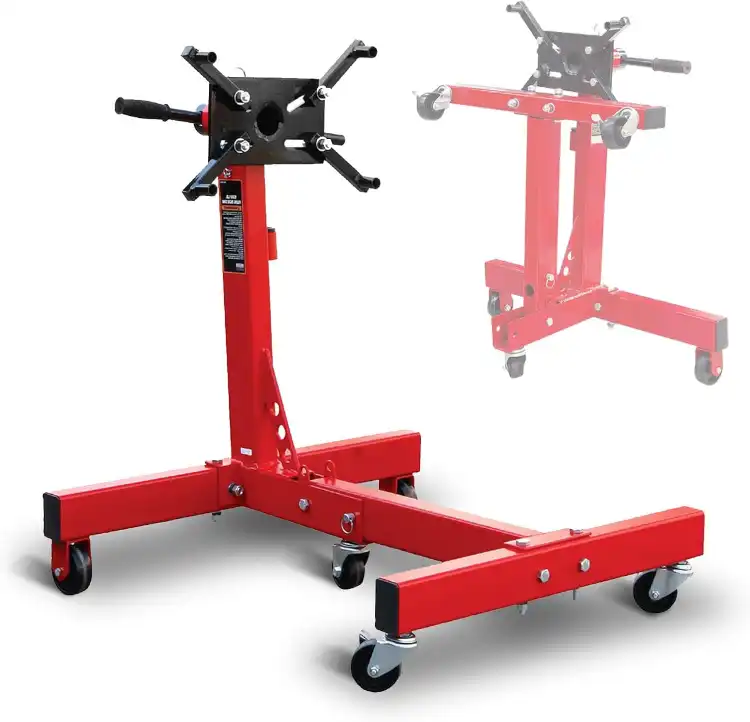
BIG RED T26801 Torin Steel Rotating Engine Stand
Check on AmazonKey Specs:
- Load Capacity: 1,500 lbs
- Rotation: 360-degree
- Adjustable Arms: Four arms for versatility
- Mobility: Two fixed casters, three swivel casters
- Design: Foldable for easy storage
The BIG RED T26801 Torin Steel Rotating Engine Stand is a top choice for both professional and amateur mechanics. With a robust 1,500 lb load capacity, it easily supports various engine types. The four adjustable arms and 360-degree rotation give you full access to every part of the engine, enhancing efficiency. Its foldable design makes it easy to store, while the five casters, including three swivels, provide excellent maneuverability. Though some initial lubrication is needed, the overall build quality ensures long-term durability.
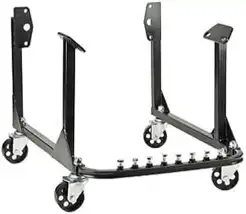
JEGS Rolling Engine Cradle
Check on AmazonKey Specs:
- Load Capacity: 750 lbs
- Casters: Four 3-inch swivel casters
- Compatibility: BB-Chevy and Gen-1 SB-Chevy engines
- Material: Heavy-duty steel
- Assembly: Easy and quick with included hardware
The JEGS Rolling Engine Cradle is an excellent solution for storing and maneuvering small and big block Chevy engines. With a 750 lbs load capacity, it provides a stable base for your engine during maintenance or storage. The four 3-inch swivel casters offer full 360-degree movement, making it easy to navigate tight spaces. Its quick assembly and heavy-duty steel construction ensure durability. While it’s tailored for BB-Chevy and Gen-1 SB-Chevy engines, its affordability and functionality make it a valuable addition to any shop.
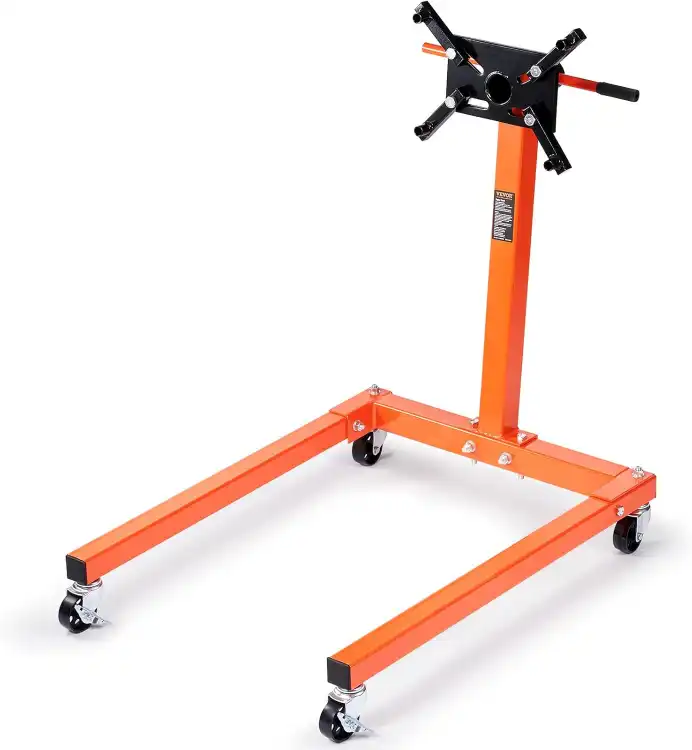
VEVOR 1300 lbs Rotating Engine Stand
Check on AmazonKey Specs:
- Load Capacity: 1,300 lbs
- Base Design: U-shaped for enhanced stability
- Rotation: 360-degree rotatable head
- Casters: Four swivel casters (two lockable)
- Material: High-strength alloy steel with electrostatic spray surface
The VEVOR 1300 lbs Rotating Engine Stand offers exceptional stability with its upgraded U-shaped base, providing superior support compared to traditional T-shaped stands. With a 1,300 lb capacity, it can safely hold most engine blocks during repairs. The 360-degree rotatable head and four adjustable arms ensure full access to the engine for efficient work. The stand’s four swivel casters, including two lockable ones, allow easy maneuverability and secure positioning. Built from high-strength alloy steel, it promises durability and long-lasting use.
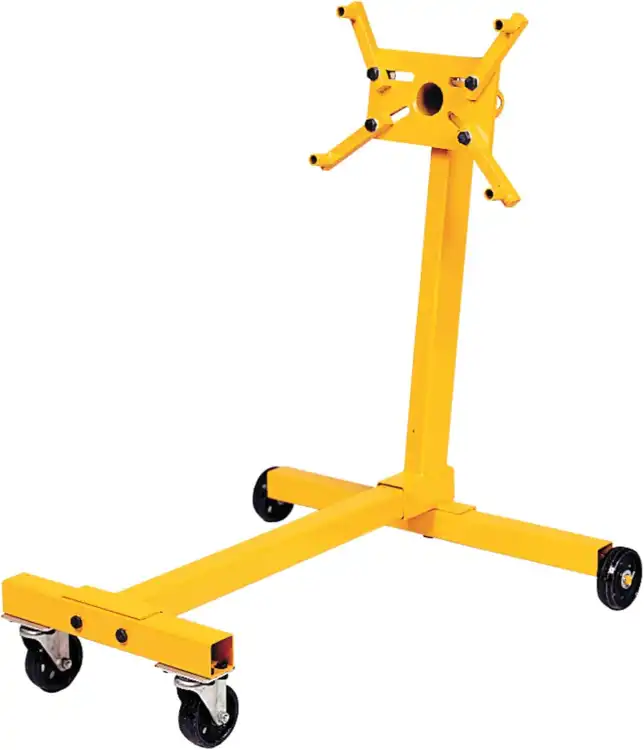
Performance Tool W41025 Rotating Engine Block Stand
Check on AmazonKey Specs:
- Load Capacity: 1,000 lbs
- Rotation: 360-degree head with six lockable positions
- Material: Heavy-duty tubular steel
- Casters: Swivel casters for easy maneuverability
- Weight: 30.4 lbs
The Performance Tool W41025 Rotating Engine Block Stand is a solid choice for any mechanic needing reliable support. With a 1,000 lbs capacity, it handles a variety of engine blocks with ease. Its 360-degree rotating head, which locks into six positions, offers incredible flexibility for detailed engine work. Constructed from heavy-duty tubular steel, it’s built to last. The swivel casters provide excellent mobility, making it easy to move the stand around your workspace. It’s a durable and versatile stand for both professionals and DIY enthusiasts.
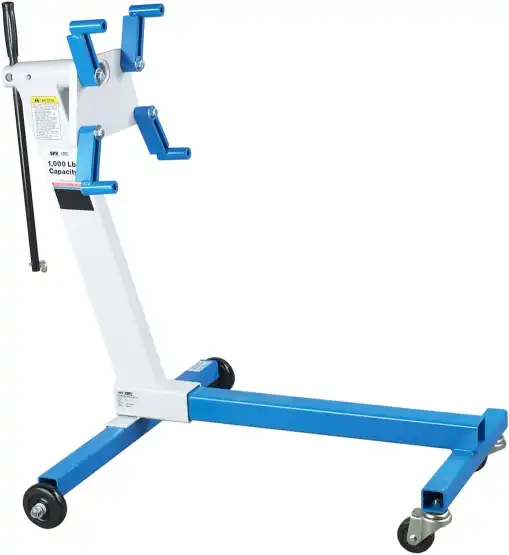
OTC 1726A Hydraulic Engine Stand
Check on AmazonKey Specs:
- Load Capacity: 1,000 lbs
- Rotation: 360-degree head with eight lockable positions
- Material: Sturdy steel construction with powder-coated finish
- Hydraulic Mechanism: For easy lifting and positioning
- Weight: 106 lbs
The OTC 1726A Hydraulic Engine Stand is a powerhouse designed for heavy-duty engine work. With a 1,000 lb capacity, it’s perfect for small vehicles and light truck engines. The 360-degree rotating head locks into eight positions, giving you excellent access for detailed repairs. Its hydraulic mechanism simplifies engine lifting and positioning, making it easier to work with heavier engines. Despite its weight at 106 lbs, its steel construction and powder-coated finish ensure durability and resistance to rust, making it a premium choice for serious mechanics.
Understanding the Importance of Engine Stands
Engine stands play a vital role in the maintenance and repair of vehicle engines. They provide a secure platform for the engine, allowing mechanics to perform a wide range of tasks, from simple repairs to complete engine rebuilds. Without an engine stand, these tasks would be much more difficult and time-consuming.
Engine stands also contribute to workplace safety. They secure the engine in place, preventing it from moving or falling while work is being performed. This not only protects the engine from damage but also reduces the risk of injury to the mechanic.
Furthermore, engine stands improve efficiency. They allow the engine to be rotated, providing easy access to all parts of the engine. This eliminates the need for the mechanic to move around the engine, saving time and effort.
Different Types of Engine Stands
There are several types of engine stands available, each designed for a specific type of engine or task. The most common types are the folding engine stand, the four-wheel engine stand, and the heavy-duty engine stand.
The folding engine stand is compact and lightweight, making it ideal for small workshops or home garages. It can be easily folded for storage when not in use. The four-wheel engine stand is more robust and stable, suitable for larger engines. It features four wheels for easy movement and a rotating mount for easy access to all parts of the engine.
The heavy-duty engine stand is designed for large, heavy engines. It is made of heavy-duty steel and features a wide base for stability. This type of engine stand is typically used in professional automotive repair shops.
Key Features to Consider When Buying an Engine Stand
When buying an engine stand, there are several key features to consider. The first is the weight capacity of the stand. It is crucial to choose a stand that can support the weight of your engine. The weight capacity of engine stands typically ranges from 750 to 2000 pounds.
The second key feature is the size of the stand. The stand should be large enough to accommodate your engine but small enough to fit in your workspace. The size of the stand is usually determined by the size of the engine it is designed to support.
The third key feature is the material and build quality of the stand. The stand should be made of durable materials, such as steel, and feature a sturdy construction. This ensures that the stand can withstand the weight of the engine and the rigors of engine work.
The Role of Material and Build Quality in Engine Stands
The material and build quality of an engine stand play a crucial role in its performance and durability. Engine stands are typically made of steel, which is known for its strength and durability. The thickness of the steel used in the construction of the stand can affect its weight capacity and stability.
The build quality of the engine stand is also important. The stand should feature a sturdy construction, with all parts securely fastened together. The welds should be clean and strong, with no signs of weakness or cracking. The mount should rotate smoothly and securely, allowing the engine to be positioned at different angles with ease.
High-quality materials and construction not only ensure the performance and durability of the engine stand but also contribute to its safety. A well-built engine stand can securely support the weight of the engine, reducing the risk of accidents or injuries.
Understanding the Weight Capacity of Engine Stands
The weight capacity of an engine stand refers to the maximum weight that the stand can safely support. It is one of the most important factors to consider when choosing an engine stand. The weight capacity of the stand should be greater than the weight of the engine you plan to work on.
Engine stands typically have a weight capacity ranging from 750 to 2000 pounds. Stands with a higher weight capacity are usually larger and more robust, designed to support heavy-duty engines. It is crucial to choose a stand with the appropriate weight capacity to ensure the safety and efficiency of your engine work.
It’s also important to note that the weight capacity of the stand refers to the weight of the engine alone, not including any additional parts or equipment. Therefore, you should always consider the weight of your engine and any additional parts or equipment when determining the appropriate weight capacity for your engine stand.
Importance of Engine Stand Design and Ergonomics
The design and ergonomics of an engine stand can greatly affect its usability and efficiency. A well-designed engine stand should be easy to use, with controls that are easily accessible and intuitive to operate. The stand should also be comfortable to use, with features such as adjustable height and angle to accommodate different users and tasks.
The design of the engine stand should also facilitate easy access to all parts of the engine. This can be achieved through features such as a rotating mount, which allows the engine to be turned and positioned at different angles. This not only improves efficiency but also reduces the risk of strain or injury to the user.
Furthermore, the design of the engine stand should consider the needs of the user. For example, a folding engine stand may be ideal for a home garage where space is limited, while a heavy-duty engine stand may be more suitable for a professional automotive repair shop.
The Role of Portability and Storage in Choosing Engine Stands
Portability and storage are important factors to consider when choosing an engine stand. If you have a small workspace or need to move the stand frequently, a portable engine stand may be the best choice. Portable engine stands typically feature wheels for easy movement and a compact design for easy storage.
On the other hand, if you have a large workspace and do not need to move the stand frequently, a larger, more robust engine stand may be more suitable. These stands typically have a larger weight capacity and offer greater stability, but they may be more difficult to move and store.
When considering storage, it’s also important to consider the size of the stand when not in use. Some engine stands can be folded or disassembled for storage, making them a great option for small spaces or infrequent use.
Safety Features to Look for in Engine Stands
Safety is a crucial consideration when choosing an engine stand. A safe engine stand should securely support the weight of the engine, preventing it from moving or falling while work is being performed. This not only protects the engine from damage but also reduces the risk of injury to the user.
Some safety features to look for in an engine stand include a sturdy construction, a secure mount, and a wide base for stability. The stand should also feature a locking mechanism to secure the engine in place, preventing it from rotating or moving unexpectedly.
Additionally, the stand should be made of high-quality materials and feature a robust construction to withstand the weight of the engine and the rigors of engine work. It’s also important to regularly inspect and maintain the stand to ensure its safety and performance.
Understanding the Assembly and Disassembly Process of Engine Stands
The assembly and disassembly process of an engine stand can vary depending on the type and design of the stand. However, most engine stands are relatively easy to assemble and disassemble, requiring only basic tools and a little time.
The assembly process typically involves attaching the base to the upright support, attaching the mount to the support, and securing the engine to the mount. The disassembly process is simply the reverse of the assembly process.
It’s important to follow the manufacturer’s instructions when assembling and disassembling the stand to ensure its safety and performance. It’s also important to regularly inspect and maintain the stand to ensure its safety and performance.
The Role of Price and Budget in Buying Engine Stands
The price of an engine stand can vary greatly depending on its type, size, material, and features. Therefore, it’s important to consider your budget when choosing an engine stand. However, it’s also important to consider the value that the stand offers in terms of its performance, durability, and safety.
While it may be tempting to choose the cheapest option, it’s important to remember that you often get what you pay for. A cheap engine stand may not be as durable or reliable as a more expensive one, and it may not offer the same level of safety or performance.
Therefore, it’s important to consider the long-term value of the stand, not just its initial cost. A high-quality engine stand may cost more upfront, but it can save you money in the long run by reducing the need for repairs or replacements and improving the efficiency and safety of your engine work.
Maintenance and Care for Engine Stands
Proper maintenance and care are crucial for the performance and longevity of an engine stand. Regular inspection and maintenance can help to identify and address any issues before they become serious problems, ensuring the safety and efficiency of the stand.
Regular maintenance should include checking the stand for any signs of damage or wear, such as cracks, rust, or loose parts. The mount should be checked for smooth operation, and the locking mechanism should be checked for secure operation. Any issues should be addressed immediately to ensure the safety and performance of the stand.
Proper care also includes proper storage of the stand when not in use. The stand should be stored in a dry, clean area to prevent rust or corrosion. If the stand is not going to be used for a long period of time, it should be disassembled and stored in a safe place.
Common Mistakes to Avoid When Buying Engine Stands
When buying an engine stand, there are several common mistakes to avoid. The first is choosing a stand based solely on price. While price is an important factor, it’s also important to consider the quality, performance, and safety of the stand.
The second common mistake is not considering the weight capacity of the stand. It’s crucial to choose a stand that can safely support the weight of your engine. Choosing a stand with a lower weight capacity can lead to instability and potential accidents.
The third common mistake is not considering the size of the stand. The stand should be large enough to accommodate your engine but small enough to fit in your workspace. Choosing a stand that is too large or too small can lead to inefficiency and potential accidents.
The Impact of Brand Reputation and Customer Reviews in Buying Engine Stands
Brand reputation and customer reviews can provide valuable insight into the quality and performance of an engine stand. A brand with a good reputation is likely to produce high-quality products, and positive customer reviews can confirm this.
Customer reviews can also provide information about the performance, durability, and ease of use of the stand. They can highlight any potential issues or drawbacks, helping you to make an informed decision.
However, it’s important to take customer reviews with a grain of salt. While they can provide valuable insight, they are also subjective and may not reflect the experience of all users. Therefore, it’s important to consider other factors, such as the specifications and features of the stand, in addition to customer reviews.
Conclusion: Making the Right Choice for Your Engine Stand Needs
Choosing the right engine stand is crucial for the safety and efficiency of your engine work. There are many factors to consider, including the weight capacity, size, material, and features of the stand. It’s also important to consider your budget and the reputation of the brand.
By understanding these factors and considering your specific needs, you can make an informed decision and choose the right engine stand for your needs. Whether you’re a professional mechanic or a car enthusiast, a high-quality engine stand can make your engine work safer, easier, and more efficient.
Remember, the right engine stand is not just a tool, but an investment in your safety and efficiency. So take the time to research, compare, and choose the best engine stand for your needs.
